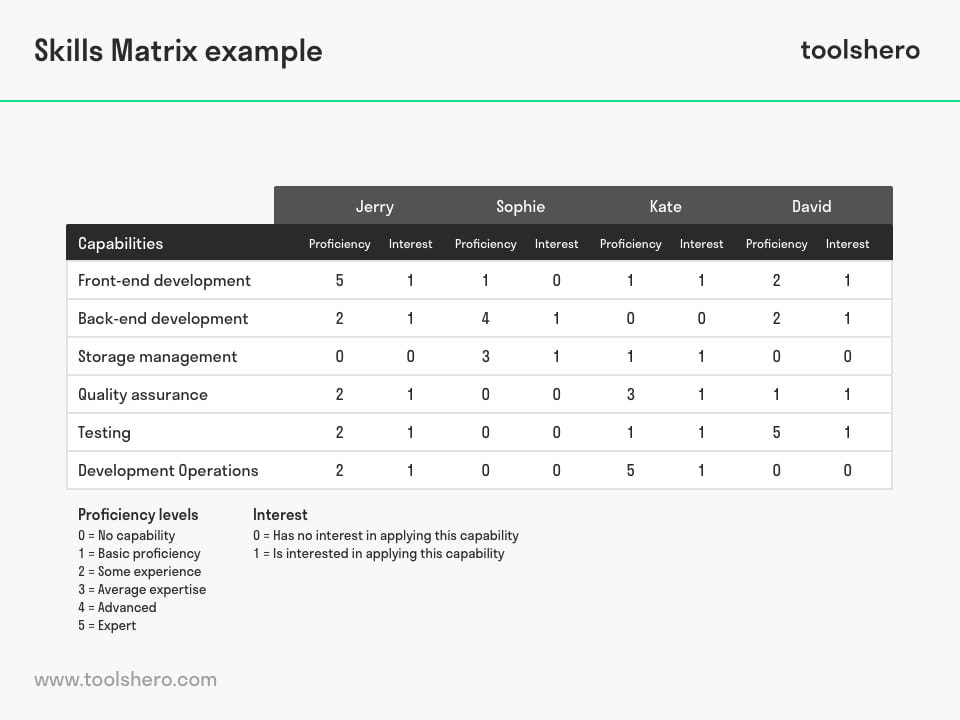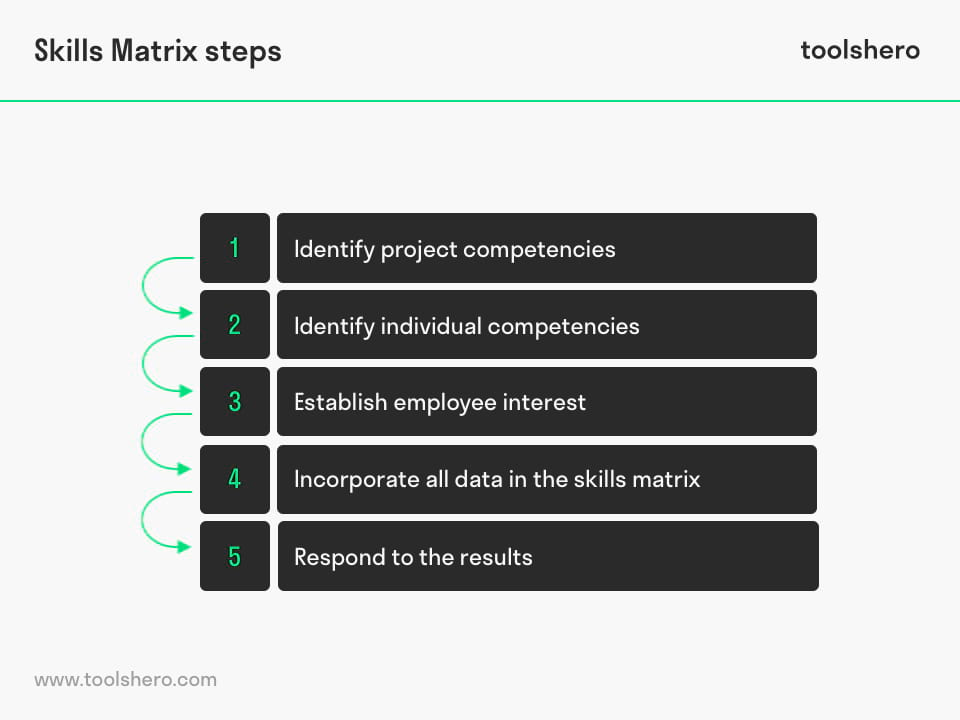Skill Matrix explained

Skills Matrix: this article provides a practical explanation of the Skills Matrix, also known as a Competency Matrix or Employee Skill Matrix. After reading, you’ll have a basic understanding of this management tool, including an practical example and a skill matrix template. Enjoy reading!
What is a Skills Matrix?
The Skills Matrix is a visual tool that helps you to clearly see the skills and competencies of individuals within an organisation, group, or team. The Skills Matrix is part of skills management. The primary goal of skills management is to offer support for understanding, developing, utilising, and tracking people and their skill levels.
The matrix is generally used for small groups of people, but can be expanded. The left side shows specific skills or knowledge areas that are required for a specific project, for instance. Next, two variables have to be entered for every name: proficiency regarding the skill in question, and interest to use the skill.
If used correctly, the Skills Matrix offers a reliable overview of the knowledge and skills available within a team. It can tell you if you have the skills necessary to carry out specific tasks and complete a project.
If the team is lacking in certain necessary skills, we call this a skills gap. This makes it an important tool for any data driven human resource manager.
Proficiency & Interest
Two central aspects when making and using a Skills Matrix are proficiency and interest. The level of proficiency indicates how proficient the employee in question is when it comes to carrying out the activity. The interest shows to what extent an employee is interested in applying their skills and to develop them further.
A high level of proficiency is a positive indicator, but doesn’t tell you everything you need to know. The employee also has to be interested in applying and developing their knowledge or skills. It is a good sign that an employee really wants to continue to develop.

Figure 1 – A example of the Skills Matrix
A distinction is made between the following levels of proficiency and interest:
Proficiency level 0
The employee does not have any knowledge or skills in the field in question. They cannot be used for the activity. It’s important that an employee with a proficiency level of 0 is introduced to the basic concepts of the activity or field that will be used in the organisation or project team.
Proficiency level 1
Level 1 is assigned to people in the Skills Matrix who have basic proficiency regarding the field or activity in question. Basic techniques and concepts have been acquired, and the focus for these employees should be on training and development.
Proficiency level 2
Level 2 is assigned to employees with some experience in a certain field or activity. They have had the opportunity to join professionals in practice a few times, or as a trainee during their studies. Level 2 means that the employee understands terminology and can talk about it. The person is also aware of relevant concepts, principles, theories, and problems. These employees also have to focus on development and gaining new experiences.
Proficiency level 3
Level 3 is average expertise. These employees have the skills and the abilities to successfully carry out the activities. It’s possible that they sometimes still need expert input from a professional, but in general they can carry out the tasks on their own.
These employees are good at what they do, but there is still room for development by focusing on expanding their skills and knowledge through experience. They’ve acquired all relevant knowledge, as well as on policy and complex procedures.
Proficiency level 4
Employees with proficiency level 4 are advanced in their field and don’t need any help when doing their work. Within the organisation, they are known as people who you can turn to with questions if you don’t know something.
These employees should focus on broader management issues or professional matters and regularly offer ground-breaking ideas or suggestions about problems in their field of expertise. In reality these employees often taken on the role of coach and share their knowledge and skills with others.
Proficiency level 5
The highest scores for the proficiency criterion Skills Matrix is 5. These employees are experts in what they do. They can effectively resolve issues, coach others, and answer any questions related to their expertise.
These employees work mostly on the strategic level of their field and have displayed excellent skills in the past. Proficiency level 5 is only awarded to employees who can come up with uniquely creative solutions for complex questions.
Interest
Interest can be given a value of either 0 or 1. A value of 0 means the employee is not interested in making good use of their knowledge and skills or develop them. A value of 1 means that the employee is sufficiently motivated and interested to use their skills and is willing to learn.
Skills Matrix step-by-step plan
Follow the step-by-step plan below to generate the data you need to create a Skills Matrix for your project group or team.

Steps to the Skills Matrix
Step 1: identify project competencies
Each project has different requirements regarding knowledge and skills. Define which aspects are important, which competencies are required, and which specific skills still need to be acquired. Divide these competencies and put them on the left side of the Skills Matrix.
Step 2: identify individual competencies
Now interview all the members of the team or group. Discuss their skills, knowledge, and interests related to the project or task objectives. Explain that you’re looking for the right level of competency for the job in order to link the right people to the right tasks.
Step 3: establish employee interest
When establishing the individual competencies, it’s important to also determine whether employees would be interested in taking on a variety of responsibilities. Try to find out if a person isn’t interested in doing a certain task, so you can change the task to make it more interesting for them.
Step 4: incorporate all data in the Skills Matrix
Collect all the information from the preparation phase of making the Skill Matrix and copy the data into the template.
Step 5: respond to the results
Now go over each team member’s part of the Skills Matrix with them and determine a score while the tasks are carried out. Give all the employees a chance to add information or offer suggestions.
This evaluation allows you to verify if the information is correct, and if the right person has been linked to the right tasks. Make changes if the data shows that you haven’t put the right people on the right tasks.
If an employee shows interest in developing themselves, try to make sure there are sufficient opportunities and support for this.
Skills Matrix as a tool
It’s not just easy for the group’s manager to know the division of skills within the group to assign resources; the Skill Matrix can also help improve the organisation’s and the individual’s performance in several ways.
A Skills Matrix for employee development
Developing the Skills Matrix and discussing its results with the employees helps them gain insight into their own competencies.
This skills based approach makes employees more aware of the skills that the team needs as a whole to deliver a strong performance. It also shows what they can contribute to do their job well, and where they’re still lacking. That’s a perfect starting point for learning and development opportunities.
Group effectiveness
First of all, the Skills Matrix is very suited as a tool to help understand the team as a whole. Because it offers quick insight into the skills that are present and lacking in a team, you can quickly recruit the right people.
The group also becomes more aware of their individual weaknesses, leading to an open work environment where employees aren’t afraid to ask for help.
Using a Skills Matrix helps customers
Eventually, more efficient and proficient employees also benefit the customers. The clients, both for external projects or clients within the organisation, want the project to be handled professionally and efficiently.
Skills Matrix template
Use this Skills Matrix template to create a reliable overview of the knowledge and skills available within a team.
Download the Skills Matrix template
This template is exclusively for our paying Toolshero members. Click here to see if a membership is something for you!Now It’s Your Turn
What do you think? Are you familiar with the explanation about the Skills Matrix? Could you use the Skill Matrix for individuals, teams or projects in work environment? What else do you think should be considered when developing a Skills Matrix? Do you have any tips or additional comments?
Share your experience and knowledge in the comments box below.
More information
- Barnes, T. (2010). Novel derivation and application of skill matrices: The q-matrix method. Handbook on educational data mining, 159-172. Routledge.
- Hockemeyer, C., Conlan, O., Wade, V. P., & Albert, D. (2003). Applying competence prerequisite structures for eLearning and skill management. J. UCS, 9(12), 1428-1436.
- Pica, G., & Rodríguez Mora, J. V. (2005). FDI, allocation of talents and differences in regulation.
- Stevens, M. J., & Campion, M. A. (1994). The knowledge, skill, and ability requirements for teamwork: Implications for human resource management. Journal of management, 20(2), 503-530.
How to cite this article:
Janse, B. (2019). Skill Matrix explained: theory and template. Retrieved [insert date] from Toolshero: https://www.toolshero.com/management/skills-matrix/
Published on: 06/20/2019 | Last update: 07/31/2023
Add a link to this page on your website:
<a href=”https://www.toolshero.com/management/skills-matrix/”>Toolshero: Skills Matrix</a>












